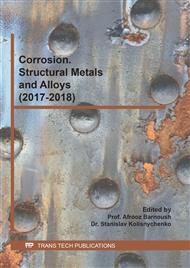[1]
R.G. Rizvanov, R.G. Abdeev, N.L. Matveev, R.G. Ryskulov, A.I. Shenknekht A.F. Insafutdinov, Effect of the geometry of the shell/elliptical-bottom contact zone on the stress state of pressure vessels, Chemical and Petroleum Engineering. 36 (2000).
DOI: 10.1007/bf02463460
Google Scholar
[2]
A.M. Shchipachev, Method of calculating fatigue durability with allowance for the influence of surface plastic deformation, Problemy Mashinostroeniya i Nadezhnos'ti Mashin. 2(3) (2001) 98-103.
Google Scholar
[3]
A.S. Tyusenkov, Chemical resistance of steel 13CrV (rus 13ХФА), Steel. 2 (2016) 53-57.
Google Scholar
[4]
I.R. Kuzeev, E.A. Naumkin, A.N. Tepsaev, A.V. Samigullin, V.A. Gafarova, Generation of the response electromagnetic signal in the process of destruction of shell structures, SOCAR Proceedings. 4(4-4) (2015) 75-80.
DOI: 10.5510/ogp20150400264
Google Scholar
[5]
Y.S. Kovshova, I.R. Kuzeev, E.A. Naumkin, I.G. Fattakhov, The process of initiation of potential fracture zones in the material of shell structures under static load, International J. of Applied Engineering Research. 11(3) (2016) 1630-1636.
Google Scholar
[6]
O.R. Latypov, D.E. Bugay, E.V. Boev, Method of Controlling Electrochemical Parameters of Oil Industry Processing Liquids, Chem. and Petroleum Engineering. 51(3) (2015) 283-285.
DOI: 10.1007/s10556-015-0038-8
Google Scholar
[7]
I.R. Kuzeev, I.G. Ibragimov, M.I. Bayazitov, S.N. Davydov, I.R. Khairudinov, Steel corrosion prevention in coking residual petroleum stocks, Chem. and Technology of Fuels and Oils. 22(3) (1985) 111-113.
DOI: 10.1007/bf00726125
Google Scholar
[8]
A.S. Tyusenkov, S.E. Cherepashkin, Scale Inhibitor for Boiler Water Systems, Russian J. of Applied Chem. 87(9) (2014) 1240-1245.
DOI: 10.1134/s1070427214090080
Google Scholar
[9]
I.G. Ibragimov, R.G. Vil'danov, Measuring stresses in welded joints by the remagnetisation loss method, Welding International. 21(2) (2007) 139-141.
DOI: 10.1533/wint.2007.3770
Google Scholar
[10]
Е.М. Gutman, I.G. Abdullin, D.E. Bugai, Kinetics of microdistortion changes of the crystal lattice and electrochemical behavior of austenitic steel during low-cycle corrosion fatigue, Protection of Metals and Physical Chem. of Surfaces. 18(3) (1982).
Google Scholar
[11]
O.R. Latypov, Reduction of salt deposits on the surface of oilfield equipment by management of electrochemical parameters of the medium, Chem. and Petroleum Engineering. 51(7) (2015) 522-525.
DOI: 10.1007/s10556-015-0079-z
Google Scholar
[12]
D.V. Karetnikov, R.G. Rizvanov, A.M. Fairushin, K.S. Kolokhov, Increasing the reliability of oil and gas equipment working in the conditions of steep temperature gradients, Welding International. 27(7) (2013) 557-560.
DOI: 10.1080/09507116.2012.715949
Google Scholar
[13]
I. Danaee, N. Bahramipanah, Thermodynamic and adsorption behavior of N2O4 schiff base as a corrosion inhibitor for api-5l-x65 steel in hcl solution, Russian J. of Applied Chem. 89(3) (2016) 489-499.
DOI: 10.1134/s10704272160030216
Google Scholar



